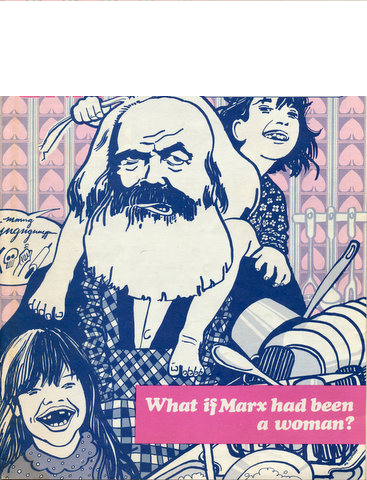
In our September Reading Group, we discussed (mainly the introduction of) the book, ‘Social Reproduction Theory: Remapping Class, Recentering Oppression’, edited by Tithi Bhattacharya. For many decades, marxist-feminists around Social Reproduction Theory (SRT) have focused on the lives of workers beyond the points of production. Their theory seeks to strengthen the understanding of the significant activities that workers carry out in the sphere away from the workplace, and how this unwaged work relates to value production.
Rather than focusing solely on how capital and the working class interact at the point of production, SRT pivots the emphasis to the totality of the life of the working class. It has looked at elements of the class beyond the traditionally perceived white, male, heterosexual layers based in the earlier ‘heartlands of capital’. At the core of the approach is an attempt to answer the first question posed in the extract below (from Bhattacharya’s introduction to the collection).
“If workers’ labor produces all the wealth in society, who then produces the worker? Put another way: What kinds of processes enable the worker to arrive at the doors of her place of work every day so that she can produce the wealth of society? What role did breakfast play in her work-readiness? What about a good night’s sleep? We get into even murkier waters if we extend the questions to include processes lying outside this worker’s household. Does the education she received at school also not “produce” her, in that it makes her employable? What about the public transportation system that helped bring her to work, or the public parks and libraries that provide recreation so that she can be regenerated, again, to be able to come to work?
The goal of social reproduction theory (SRT) is to explore and provide answers to questions such as these. In doing so, SRT displays an analytical irreverence to “visible facts” and privileges “process” instead. It is an approach that is not content to accept what seems like a visible, finished entity—in this case, our worker at the gates of her workplace— but interrogates the complex network of social processes and human relations that produces the conditions of existence for that entity.”

Points of debate
- How useful is SRT in making a more detailed analysis of different types of work in capitalism and how they relate to each other?
SRT has been really crucial in making women’s (often historically unwaged) work visible within a marxist understanding of capital. The ‘Wages for Housework’ campaign in the 70s was a key turning point here. But, as the quote above states, the water becomes muddied very quickly, in terms of what counts as SR and not – it can seemingly encompass everything!
‘Social reproduction’ within the context of a capitalist society could mean at least four significantly different things:
1) Domestic activity that immediately reproduces labour power (child-rearing, cooking, domestic care work, education);
2) Wage labour that immediately reproduces labour power (domestic services, public services such as education or healthcare). This is unproductive labour in the sense that no commodities are produced that expand the material basis for the reproduction of either labour power or capital;
3) Labour that produces commodities that enter the social reproduction of labour (food production, manufacturing of washing machines) – and its unproductive counterpart in the form of consumption goods for capitalists;
4) Labour that reproduces the society as it is, namely, as a class society (state administration, police apparatus, prison system).
In order to produce a ‘theory’, we would have to say more than: “all this is ‘social reproduction’”. Obviously everything is connected and fairly fluid, but we have to distinguish certain tendencies within capitalism when it comes to social reproduction, and clearer categories might be helpful doing this.
As a group, we weren’t sure if SRT, as explained in this book, manages to do this in a coherent and systematic way.
- Has SRT adequately analysed the distinctions between unwaged and waged reproductive work? And what are the reasons and consequences?
During the discussion, comrades noted that parts of social reproduction have increasingly been commodified and transferred into the process of commodity production (care home workers, cleaners, large scale laundries, ready-meal production etc.). Social reproduction is now both waged and unwaged. There have been more recent texts that try and account for more accuracy here.
A peculiar tendency of capitalism is that compared to previous societies, the labour that’ goes into ‘reproduction of labour and consumption of the exploiting class’ has been radically reduced. Of course labour is necessary to immediately rear or care for workers, to produce food or clothing and of course capitalists consume an awful lot – but compared to, for example, a feudal society, this share of social labour has shrunk a lot. From 80% of people who work in agriculture to 5%. From whole households engaging in domestic production and subsistence to ‘double income’ wage working households.
In capitalism a large share of social labour is invested either in ‘the production of the means of production’, in ‘the circulation of commodities or money’, or ‘the state apparatus’, which only partly covers the immediate reproduction of labour power (‘welfare’). Another big shift – which is the material basis for the development of feminism in general – is the shift from domestic labour to wage labour of women. To conflate ‘formally unpaid’ domestic reproductive labour with reproductive wage labour would undermine our understanding of the changes in material basis of emancipation.
“As a consequence of terming everything ‘labour’, throughout the text the author has problems to describe how the ‘domestic labour’ relates to ‘productive labour’: She writes: “production of goods and services and the production of life are part of one integrated process” (p.3) – But what does ‘integrated’ actually mean here? And then:“This version of social reproduction analyses the ways in which both labors are part of the same socio-economic process.” (p.5) Here it turns into the same process. How is this clarifying?!”
The tendency within ‘social reproduction theory’ to call everything ‘work’ creates problems, in particular if we try to understand the contradictory nature of capitalist nuclear families and households. Again, the political impetus to call cooking a meal at home ‘unpaid labour’ is understandable. We want to show that private and often invisible activities are a precondition for capitalist production. That is fair enough. But it is important to make distinctions, which the author herself recognises when she says that domestic labour ‘happens outside the immediate control of capital’.
“The volume did leave me with lots of questions when it came to what constitutes ‘social reproduction’. It says in the intro that Marx said that one of the ways in which labour power is unique, is in that it is not produced capitalistically. And then that the implications of this are “underdeveloped in Marx.” Reading the volume and taking it as correct, it seems that almost anything (except the most obviously decadent of consumption) is produced capitalistically. If a second circuit of production (M-Ac-P-Lp-M), as presented by Bhattacharya in chapter 4, incorporated as a distinct but related circuit of the first circuit presented by Marx in Capital (M-C-(Mp-Lp)-P—C-M), what is to be excluded from the Articles of Consumption (Ac) that go into reproducing labour power? Soap, healthcare, media, nail clippers, education, carpet? Are all the things consumed (the socially necessary labour time including the labour power of those caring or cleaning for us) by labour power in an effort to reproduce itself as a commodity (a quantity, the book suggests, that is massively contingent on particular historical situation) considered a part of capitalist production/reproduction? It is obviously helpful and necessary for us to understand our system as in some ways a totality, but I did get lost a bit in places.”
This is true and perhaps it is the peculiar nature that ‘cooking a meal’ is not work in a capitalist sense, which gives the nuclear family and the domestic sphere this role of political stability in capitalism. The nuclear family is a contradictory outcome of the struggle for bourgeois freedom, against serfdom and slavery. Labour power in capitalism is typically not reproduced in mass dormitories or canteens, where capital would have a direct control over reproductive labour. And although ‘domestic labour’ is formally unpaid, it is actually more expensive to reproduce labour power in a nuclear household – as the domestic labour is actually paid via a household wage. Neither is labour power typically reproduced as slave labour, where cooking a meal would actually enter in the production of a commodity: the slave.
In this sense ‘the family’ is both an expression of fought-for bourgeois freedom (‘I can choose to hoover or not’) and patriarchal integration (‘the wage of my husband/partner gives him the power to ask me to hoover’). The bourgeois family is an unproductive, but politically stabilising expense and compromise in capitalism. It does not help clarify anything to call everything ‘work’ or to extrapolate mathematically how washing your clothes at home might contribute to surplus value production. The political problem is much bigger, which becomes visible when we look at practical consequences: the calls for ‘domestic strikes’ remain more of a gesture and don’t really turn into a strategy.
Another theoretical and empirical issue with the theory that ‘unpaid domestic labour’ creates surplus value via value transfer through the wage labour of the (male) recipient of the domestic work: we see the lowest wages and highest levels of exploitation when (male or female) migrant workers come alone to urban or metropolitan areas and leave their families behind in rural parts or the global South. In this case they undertake the domestic labour themselves and their wage is only high enough to reproduce the household ‘back home’, where reproduction costs are cheaper, in particular if the family still engages in subsistence activities, such as small-scale farming. Capitalism thrives in this situation of ‘semi-proletarianisation’ and it is often a struggle of wage workers to earn enough in order to bring the whole family into the urban area of the ‘new country’. This process is described in the concrete terms of the Indian context here.
- What SRT doesn’t emphasise…
The political impetus of social reproduction theory is the insistence that ‘reproductive labour’ is socially significant. Women’s work definitely matters. At the same time isn’t it also important to emphasise that ‘social reproduction’ (on an individual and unwaged basis) has become relatively more insignificant in capitalism. Why? Firstly in order to be able to point out the absurdity of capitalist production and the potential of emancipation. Given the level of social productivity we don’t have to toil on the land anymore, or wash clothes by hand, but will still work ourselves to death – why is that?
And secondly, emphasising the relative reduction of individualised and unwaged reproductive work is needed in order to criticise the common leftist proposals of how to solve the capitalist crisis, e.g. through redistribution of wealth. People assume that we can solve the crisis by giving workers more money and/or by taxing the consumption of the rich. This would only be the case if ‘social reproduction’ was at the centre of society, meaning, if workers wages and capitalist income was the determining factor in the economy and its crisis. This is not the case. Which leads up to our next point…
- Does SRT run the risk of affirming certain types of work when it should actually be abolished?
One could say that ‘Wages for Housework’ became a slogan for expanding and strengthening waged labour, rather than moving towards its abolition. In Caliban and the Witch, Silvia Federici writes:
“At the risk of being blunt, I will summarize certain feminist responses to housework: a demand for better sharing of this burden and for wages; the theory that showed how female domestic workers facilitate white and middle class women’s entry into the paid labor market in increasingly larger proportions; the Marxist feminist theory of reproductive labor and capital; the exploitation of migrant women doing the work caring/cleaning ; the critique by feminists of color worldwide of a white feminism that framed white women’s liberation in terms of “freedom from housework” and pushed for removing legal and social barriers to women entering wage labor, thus cementing the racial divide.”
- What is the relationship between SRT as a theory and its praxis for emancipation?
So in terms of political strategy, we’re dealing with different kinds of movement in response to e.g. the crisis of the NHS or of energy bills, than free childcare or ready-meal workers. The question is always, how can we develop a strategy which unites diverse spheres of resistance. Opinion diverged around whether SRT as a theory helps in this aim. Another point to consider is around the “care” and “control” aspects that are both embedded within the sphere of social reproduction. How do we differentiate between the two? And what implications are there for a new way of organising society?
————
Some individual, general comments:
“…if we call everything work, where is the potential for liberation?”
“The volume was really helpful for me personally when it came to getting my head around some Marxist concepts more generally. Something about the way it was addressed in some of the chapters really helped things sink in in ways that other material hasn’t. The way that forms of appearance are broken down by analysis (like the “superficial nature of spatial divisions between production (public) and reproduction (private)) and the importance of contradictions in our ability to grasp what’s happening and understand crises (drives for accumulation threatening and destabilising reproductive processes).”
“Going into reading the book I was expecting the remit or scope to be a lot smaller or more focused. Maybe focusing on unwaged work/non market production and making connections along the way. It turned out to be a much grander method that was “recasting the labour theory of value.” Very stimulating but adds lots of complexity. This appears to be part of the motivation when Bhattacharya states that “instead of the complex understanding of class historically proposed by Marxist theory……..today’s critics rely on a narrow vision of a “working class” in which a worker is simply a person who has a specific kind of job.””
“All in all I thought the text was annoying in the sense that it used very academic language on one side, but then poured everything together into one big pile that includes all kinds of forms of labour and all kind of forms of exploitation and oppression (“race and gender are actually co-constitutive” (p.17) / “categories of oppression are co-produced in simultaneity with the production of surplus value” (p.14) etc.)”
“To me SRT leaves the weird taste that it is just a bunch of so called “critical” academics that have to generate text and buzzword to further pursue their careers, while it does not do anything for the people or gives us any help in how and where to start organising anti-capitalist counterpower. However one comrade pointed out in the discussion that many SRT-academics are involved in social justice movements too. Beside that for people who are indifferent or opposing of a marxist analysis but regard themselves “critical thinkers” SRT is an approach that can invite people to dive into investigating social relations and society from a Marxian point of view. So after all SRT might have the potential to somewhat radicalise liberal thinkers.”
___________

Some nitpicking:
“If we go through the text we can see that the tendency to subsume everything into ‘social reproduction’ or ‘reproductive labour’ is problematic. The problem starts on page 1, to quote: “If workers’ labor produces all the wealth in society, who then produces the worker?” The author refers to Marx here, but Marx himself was critical of such an assumption that work is the basis of all wealth. In his critique of the Gotha Program he first quotes the draft text of the program and then continues to criticise it:
“First part of the paragraph: “Labor is the source of all wealth and all culture.” Labor is not the source of all wealth. Nature is just as much the source of use values (and it is surely of such that material wealth consists!) as labor, which itself is only the manifestation of a force of nature, human labor power. The above phrase is to be found in all children’s primers and is correct insofar as it is implied that labor is performed with the appurtenant subjects and instruments. But a socialist program cannot allow such bourgeois phrases to pass over in silence the conditions that alone give them meaning…”
“I didn’t understand her effort on page 7 to explain the difference between a ‘normal commodity’ and ‘the commodity labor power’. She says that the normal commodity, “through an act of “necromancy,” turns use value into its direct opposite [exchange value]. But labor power becomes a “commodity” without going through the same process of “necromancy” as other commodities”. But is exchange value the total opposite of use value? And secondly, is the act of exchanging wages for “labour time” not a similar process – the difference is that a) the exchange is phoney, as it’s not your actual labour time that is paid and b) that the consumption of the commodity labour power can create more value than it ‘contains’.”
“On page 2 I found the explanation of what makes labour ‘capitalist’ very moralistic and unclear. To quote: “Capitalism, however, acknowledges productive labour for the market as the sole form of legitimate “work,” while the tremendous amount of familial as well as communitarian work that goes on to sustain and reproduce the worker, or more specifically her labor power, is naturalised into nonexistence”.
Here capital is described as a kind of judging subject, that acknowledges or doesn’t. Here capital turns into a power relation, the power over definition. The actual material difference of labour is ignored, e.g. I can industrially speed up the process of commodity production, I cannot do the same thing with the rearing kids.”
Further reading:
Suggestions on Marx and nature:



